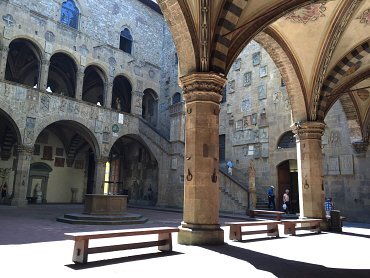The Islamic collection at the Bargello Museum

The Islamic collection is one of the jewels of the Bargello Museum in Florence. The hall, adjacent to the tower, belongs to the oldest part of the building and includes work in various materials, from textile to ivory, from gold to silver.
Not lying on the sea, Florence has never had the great contacts with the East which instead have characterized the history of other Italian cities like Pisa, Genoa, Venice, Naples and Palermo. Nevertheless, its high level of culture in the Middle Age, Humanism and Renaissance, its extraordinary richness of works of art and the collecting of many noble and wealthy families - first of all the Medici - as well as the great tolerance that the city has always demonstrated to the Jewish community, have made Florence one of the wealthiest cities in Oriental cultural goods and manuscripts in Italy and Europe.
A large part of them are kept at the National Library, at the Archaeological Museum and at the Museum of Anthropology and Ethnology. Some of these materials are stored in the Islamic hall at the Bargello Museum, also considered one of the best in Italy. Since 1982, the hall houses Islamic objects from the Grand Ducal, Carrand, Franchetti and Ressmann collections, which include metallic objects of XIII-XV century, majolica, ivories, jewels, weapons, carpets, fabrics.
In particular, some objects document the interest of the Medici and Lorraine families towards of the Oriental craft. Two brass beaten, pierced and damascened burners of the XIV and XV centuries are, for example, attributable to the collecting of Cosimo I. While the hemispheric box in wrought and engraved brass signed by the master Zaim for the Sultan Din 'Umar belonged to Ferdinando I. A cup in fused brass damascened in silver of the XII-XIV centuries and part of the so-called “magic cups" comes from the Grand Ducal Armory. While among the art of pottery stand out Persian examples of the XII-XIV centuries, tiles produced in Kashan with calligraphic decoration and Turkish tiles from Iznik with floral decoration and soft colors inspired by Chinese porcelain. Furthermore there are five carpets, imported in Florence in the early decades of the XV century, all of the highest quality, four coming from Anatolia and one from Persia. The museum also houses a rare example of Islamic glass, the lamp of the mosque, from Syria and dating back to the XIV century. There's a very rich display of ivories formed by splendid examples including the six Egyptian plates of the XII century, the small pieces of chess from Iraq (IX-X centuries) and the Oliphant from Sicily (XI century). To complete the collection there are also some Persian and Turkish weapons dating back to the XV-XVII centuries coming from the Imperial armory of Istanbul.
Unfortunately in July 2006 a showcase in this room was broken and three highly valuable jewels were stolen: a gold necklace, a pair of earrings of the XII century and a ring with pendant of the XIII century. All in broad daylight and opening hours.











